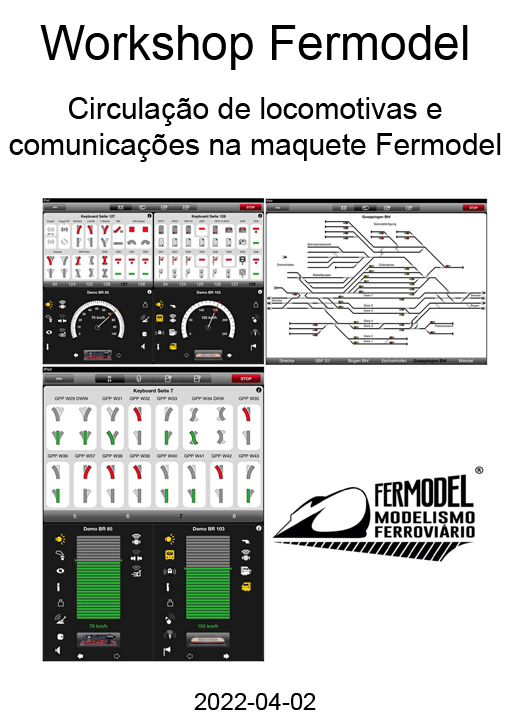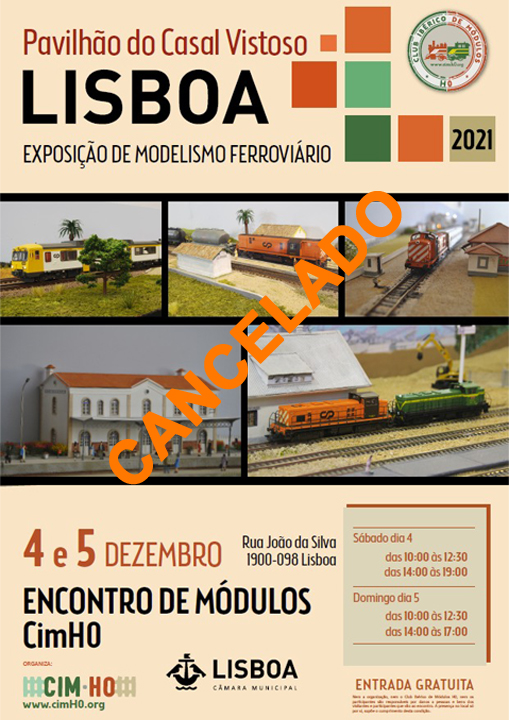"The train was also pulled by horses of a different breed; steeds with no mane, no elegance, no beautiful colours - horses that didn't neigh and didn't have vaulting skills.
They were animals from a new stud that came to transform everything, making a revolution deeper than the one felt by the primitive tribes, when domesticated the horse-beast.
Now, the horsepower, a fighting weapon of a class that would rise to the peaks of life and wanted to spread around the world. It was a powerful force that would conquer markets, promote industries, unleash needs and create countries."
Alves Redol (1911 - 1969), Portuguese neorealist writer.
Photos of this venue:
On the October 16th 2021, Fermodel group realized one of the pillars of its existence and goals, as an organization identified as the “Association of Friends of Railroad Modelling”, with a visit to the National Railway Museum at Entroncamento.
This event was possible to perform due to the Fermodel Board Members enthusiasm and dynamism, by the commitment of Fermodel Member José Manuel Salgado, as well as Dra. Maria José Teixeira (Museum Board Director) endorsement, with 33 people participating, including members of Fermodel, family and friends .
The visit took place in the morning, being taken through out the Museum galleries under the guidance of Mr. João Paulo, who proved to be a very knowledgeable guide, mentioning very interesting details, not only about the museum but also intervening, explaining the “whys and hows” of wrong decisions taken regarding the national railway plan, prompting the intervention with the visitors about the future of the railway in Portugal.
The visit itself suggests two phases, the first one in which we learn about the beginning of the railways, evoking the history about the epic construction of the railways and the beginning of the railway in Portugal and in the world.
The second phase of the visit can be characterized by a journey through out the time, spiked with a visit to the museum rolling stock heritage.
In a first approach provided by the museum guide, Mr. João Paulo, we learned that museum heritage collection is made up of about 36.000 objects, small and large, which can be classified in the following categories: Railway rolling stock; Track and Catenary Equipment; Workshop Equipment; Communication, Information and Signalling Equipment; Station, Office, Ticket Price List and Ticketing Equipment; Protection and Security; Restoration Equipment; Textile Equipment; Health Equipment and a valuable collection of documents assets.
The visit began in the building known as “Víveres Warehouse”, where used to be a warehouse that, for decades, served as a supply food and other necessities for the families of the railway workers at more affordable prices. It was designed by the prestigious Portuguese architect Cottinelli Telmo in 1939.
Nowadays, the “Armazém de Víveres wharehouse” houses one of the museum's exhibition halls, incorporating the visitors reception services (ticket office, shop, cafeteria, WC), as well as a room for temporary exhibitions. The permanent exhibition begins in this building, consisting of objects and contextualized information on social services provided by railway workers, such as apprentice schools, medical services or holiday camps. The professions related with the railroad deserve special attention, with the representation of some figures and the clothing used in the most remote times.
The smallest pieces of the collection are gathered in this space (workers' everyday tools, ticketing objects, communication instruments, station equipment) where the miniature steam locomotive – La Liliputienne – the toy locomotive offered to the Portuguese Royal Family by Louis Philipe the King of France, stands out. Also impressive is the model replica of the Pacific no. 1501 steam locomotive, built in 1940 by apprentices at Barreiro Workshops.
In this building, by way of a preamble, the museum guide placed greater emphasis on the steam engines period, addressing topics such as the railway infrastructure - bridges, tunnels and stations that are fundamental for the operation of this means of transportation, the materials and equipment used, the tools used by employees, either when manoeuvring trains or carrying out their day-to-day work in workshops, where rolling stock was subject to repairs and maintenance.
Then we moved on to the second phase, which would be the corollary of the visit of the Fermodel group, which began at the “Locomotives Round table”, usually known in the railway jargon as “Redonda”, whose semi-circle-shaped building served for parking and maintenance of steam locomotives. It has a turntable where the 14 lines of its interior converge and this platform is used to reverse the direction of the locomotives or simply store them. Here it was possible to see the steam locomotive “001”, the first to circulate under the aegis of CP, as well as the steam locomotive “0135”, that participated in the construction of the Beira Baixa railway line, considered by many experts as a true masterpiece in the railway world.
The group was then taken to the area where the “Portuguese Royal Train” was located, which deserved a special attention due to the luxury and comfort inside the coaches where the royal family travelled. This consist was used by the Portuguese Royal Family when traveling to the south of the country and, mainly on the trips to Vila Viçosa, for the country residence. The Royal Train consists included the D. Luiz steam locomotive locomotive with a tender, as well as the Queen Maria Pia's Carriage and the Prince's Carriage.
A detail that didn't go unnoticed was the fact that the Royal Family and their accompanying members travelled comfortably installed, but the locomotive engineer, who was responsible for all of their lives, travelled outdoors, subject to winter weather or the harsh summer sun .
As a curiosity, it should be noted that the D. Luiz locomotive was ordered from the English manufacturer Beyer Peacock & Co, Manchester, being completed in 1862, for traction Queen Maria Pia's carriage and named after the King Luís I. It had an exquisite and unique design, and that same year it was exhibited by the manufacturer, having been awarded with a gold medal at the London International Exhibition, before being handed over to the Companhia dos Caminhos de Ferro Portugueses (Portuguese Railways Company) in the south of the Tagus.
Later, with the establishment of the Republic in 1910, this consist remained in service carrying out suburban trains on the Southern Line but was later withdrawn from service in 1923.
It was also possible to visit the area with the electric and diesel locomotives, with a special attention given to the “1311” diesel locomotive, that replaced the steam locomotives serving the Beira Baixa railway line.
It's interesting to mention here an historical moment, revealing the importance of the introduction of the “1300” diesel locomotive class in Portugal.
In the mid-twentieth century, the Portuguese Railway Company (Companhia dos Caminhos de Ferro Portugueses) started a modernization program in order to improve its services; As part of this project, twelve diesel-electric locomotives where ordered, with the support of the National Development Fund, under the Marshall Plan.
Thus, in 1952, the American Whitcomb Locomotive Company built 12 diesel traction locomotives, numbered from 1301 to 1312. They were about 16 meters long, 96 tons weight with 1350 horsepower and could reach up to 132 kilometres per hour.
It would be the end of the steam era in Portugal…
Finally, the visit culminated with the splendour of another CP composition, the “Presidential Train”, also known as the “Blue Train”.
The creation of the so called “royal trains” dates back to the second half of the 20th century. XIX, in which special compositions were prepared and suited for the use of kings and emperors in the exercise of their functions, since, in a Europe governed by constitutional monarchies and empires. It was essential to endow the executive power with means of transport worthy of the monarchy. The railways were a novelty and played a decisive role to the acceleration of the transport of people and goods, with the growth of the countries own economies, which could not be neglected by the monarchs themselves at that time.
Of course, in national terms, this consist was converted into a “Presidential Train”, having travelled on it, among others, Marshal Carmona, Salazar, General Craveiro Lopes and Admiral Américo Tomaz. More recently, this composition took trips along the Douro railway line for gastronomic purposes, with famous “Chefs” being invited to prepare their tasting menus.
To end our report, we would like to empathize that the visit to the museum was very interesting, mainly because it was accompanied a guide who knew what he was talking about, in a very lively and enthusiastic way, providing the possibility to know the history or parts of the museum that most people didn't know, namely the younger generations.
In addition to the beauty of the locomotives, the high level of maintenance provided and the educational project are also highlighted by the existence of a museum of this nature.
What the group retained is nothing more than learning about the importance of rail transport, but, no less important, the preservation of our culture, as it was through the railways that many populations were able to improve their standard of living and have access to cultural means that at the time were exclusive to populations living in large metropolises.
The last but not the least and as a proposal, the museum should become a symbol of progress and modernity, with two train journeys across the country, showing the importance of rail transport to the majority of the population, namely placing a locomotive steam pulling the royal train and the presidential train, pulled by the blue English Electric Diesel 1400 class locomotive.
Text by the Mário Mendes (Fermodel Member)
Photos of this venue:





















